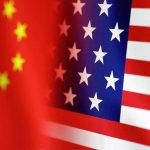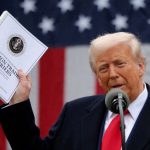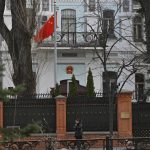2016-02-09
.jpg)
Protesters clash with riot police as they set a fire at a junction in the Mong Kok district of Hong Kong, Feb. 9, 2016.
EyePress News
Hong Kong police fired warning shots over the heads of a crowd and arrested more than 60 people following violent clashes that lasted through the night in the city’s gritty working-class district of Mong Kok, officials said on Tuesday.
The clashes broke out when unlicensed food vendors took exception to police attempts to clear their stalls, set up to catch the crowds of people welcoming in the Year of the Monkey on the neon-lit streets of Kowloon.
Hong Kong‘s security chief Lai Tung-kwok laid the blame at the feet of the vendors.
“Police officers were knocked down on the ground and were further attacked, so other police officers had to take all necessary actions to keep the peace,” Lai said, after confirming that two warning shots had been fired.
Police initially said 44 people were injured in the clashes, although later estimates suggested the number was closer to 120.
Video footage of the violence showed people in civilian clothes being carried away on stretchers or given first aid by police, some streaming with blood after being hit by police batons.
Other shots showed a row of civilians holding up plastic shields and wielding makeshift batons in a face-off with riot police in the semiautonomous city, which returned to Chinese rule in 1997.
Police were also shown hunkered down under their shields while attackers rained paving bricks down on them, while another showed a crowd in civilian clothes holding up books and newspapers to ward off pepper-spray being fired by police.
Mong Kok district police chief Yau Siu-kei said the attackers had “threatened the lives of police officers,” leaving no alternative but to fire warning shots, according to a government statement.
The attacks, which took place in the same streets as the most violent clashes of the Occupy Central pro-democracy movement of 2014, were described as a “riot” on the part of “violent radicals,” by Hong Kong officials.
“Yesterday evening a large number of violent radicals maliciously damaged government property and police vehicles, committed acts of arson, and attacked police officers on duty,” Hong Kong commissioner of police Stephen Lo told journalists on Tuesday.
He said that journalists covering the clashes, which broke out on Nathan Road, Shandong Street, Argyle Street, and Nelson Street, were also attacked.
“Police do not rule out that it was an organized and preplanned action,” Lo said, adding that investigations into the violence will continue amid reports that vehicles full of “supplies” were found near the scene.
Actions of a violent ‘mob’
Chief executive Leung Chun-ying condemned the clashes as the actions of a violent “mob,” saying that “a few hundred people” were involved.
“There was a riot in Mong Kok in the early hours of today,” Leung said. “They damaged police cars and public property, committed acts of arson, and threw bricks and other objects at police officers, including those who had already been injured and were lying on the ground.”
“The SAR government strongly condemns such violent acts,” he said, adding: “The police will apprehend the [rioters] and bring them to justice.”
Police said on Tuesday they had arrested 47 men and seven women aged 15-70 for unlawful assembly, assaulting or obstructing police officers, possessing weapons, and disorder.
Several journalists covering the riot were also injured, sparking condemnation from the Hong Kong Journalists’ Association (HKJA).
It said a cameraman for broadcaster TVB was attacked with a broken bottle, sustaining a hand wound while trying to protect himself, while a Cable TV cameraman and a radio journalist for government broadcaster RTHK was hit on the head by a brick and his audio equipment smashed.
Police also reportedly attacked a journalist for the Ming Pao newspaper who was filming the riot from a bus, even after he produced a press card, leaving him requiring stitches, the HKJA said.
“There is no excuse whatsoever for resorting to violence to resolve differences,” the group said in a statement on its Facebook page on Tuesday. “We call on the police to bring the perpetrators to book.”
Mong Kok was quiet by the time business owners arrived to open up shop, amid warnings from police to tourists to avoid the area.
“There’s some damage, a hole in my door, which happened when things got a bit out of hand,” the owner of a Monk Kok store surnamed Lo told RFA on Tuesday. “It should be OK, though.”
A nearby resident surnamed Pang said he wasn’t bothered by the incident, although he thought the stall-holders were in the wrong.
“I don’t support them; that’s the law … and it was getting so that there was less and less space to walk down the street,” he said.
“I’m not afraid; this wasn’t a big deal, not after we lived through the Occupy Central movement,” he said. “We’ve got nothing to fear; we don’t take part in any of these things.”
Pang said he understood why police had fired warning shots, given the scenes that were broadcast on television.
Agents provocateurs
Pan-democratic lawmakers, who were broadly supportive of the 79-day Occupy Central civil disobedience movement, hit out at the violence, but said they suspected the involvement of agents provocateurs.
“They pushed it to a degree that society finds unacceptable,” pan-democratic lawmaker Albert Ho told RFA.
“We are very worried about whether some people got involved from outside [the dispute], and escalated the whole thing deliberately, so that it invite public condemnation,” he said. “This definitely needs further investigation.”
Nathan Road and Mong Kok were also the scene of violent clashes in the British colonial era in 1966, which began with a peaceful protest over a fare increase on the iconic Star Ferry service that hit the city’s poorest hawkers and traders hard.
Provocateurs acting for the Chinese Communist Party were blamed for escalating the 1996 violence, although democratic legislators have also accused the British of heavy-handed suppression of the initial protest, which also came at a time of economic hardship.
Hong Kong political commentator Poon Siu-to said many working people in Hong Kong are increasingly squeezed by sky-high rents and property prices as well as slowing economic growth amid a wave of factory closures in the Pearl River delta.
“Actually people at all socioeconomic levels are dissatisfied right now, and some people have heavy financial burdens and a lot of worries,” Poon said. “The problem is that there aren’t many opportunities for the younger generation.”
He said that the blame for the violence should ultimately be laid at the feet of Hong Kong authorities.
“This time, really, I think it’s the SAR government that has been creating its own time bomb, and that’s what triggered this incident,” Poon said.
Democratic Party lawmaker Cyd Ho agreed.
“Ultimately, this question of how this very minor incident sparked a prairie fire comes down to the policies of the SAR government, particularly in the last three years,” she told a news conference.
“The administration of Leung Chun-ying has continued to provoke the people of Hong Kong with systemic violence, like the large number of incidents of police abuse of power during the Occupy Central movement of 2014,” she said.
“Relations between the people and the police are very tense, and young people in particular are angry, and Leung’s administration should bear the final responsibility … for that,” she said.













